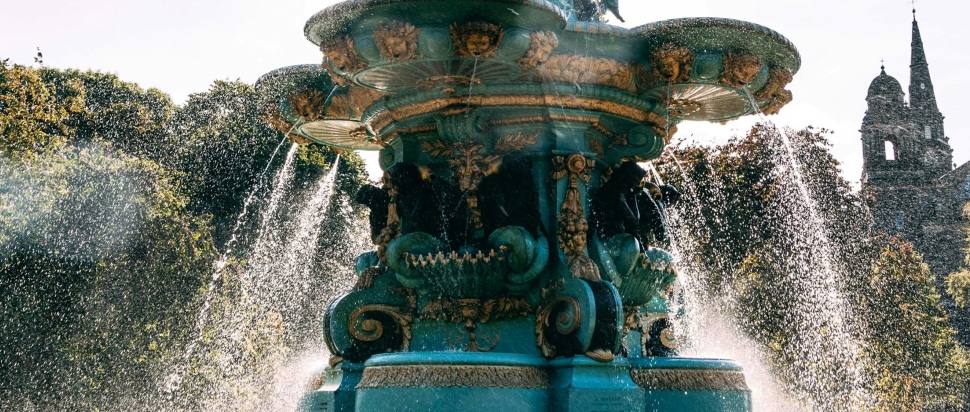Queering Memory Lane: Mapping Edinburgh's LGBTQ+ history
This February, Lavender Menace Queer Books Archive spotlights Edinburgh's queer history in exhibition Desire Paths: Reading Queer Edinburgh. To celebrate, one writer takes a look at a handful of the city's landmarks and their queer tales
Before gay bars, apps and law reform, queer people were forced to find more inventive ways to meet each other. Calton Hill’s after dark tales are well-shared, but many other unassuming Edinburgh landmarks also had a reputation for cruising and cottaging.
Register House: Cottaging Central
Standing on the pavement outside Register House – where various enthusiasts attempt to proselytise passersby – you may not realise that there are disused public toilets under your feet. But they were once so well-known for cottaging that generations of gay men referred to them as 'GHQ' (general headquarters).
A door on the left corner of Register House led downstairs to a long curve of about three dozen toilets. Out of politeness, queer men would leave the first few cubicles vacant for those who actually needed the loo. The rest, though, were fair game.
Hot and Humid in the Russian Baths
Russian baths, a more humid precursor to the modern sauna, were popular in Scotland before the Second World War. And in 1930s Edinburgh, they were steamy in more ways than one. The Russian baths at Glenogle Swim Centre and Infirmary Street Baths (which is now Dovecot Studios) were popular gay cruising spots.
Inspector Merrilees, an overzealous police officer who waged a 'war on homosexuality' in the 1930s, assaulted two men in the steam compartment at Infirmary Street for allegedly hitting on him. Police surveillance on the Russian baths revealed that the vast majority of visitors were there for 'homosexual practices', many of them having travelled from outwith Edinburgh. The police report resulted in the temporary closure of the Russian baths at both Glenogle Road and Infirmary Street.
Sailor’s Delight at Rosebery Hotel
Most people passing the respectable-looking Rosebery Hotel opposite Haymarket station in the 1930s probably had no idea it was the base for a group of queer sex workers. But this was well-known to many sailors, who made up most of the group’s clientele. The sex workers used camp nicknames such as Lady Godiva, Blondie, Annette Page and Princess Marina. Blondie fell in love with a sailor called Jack and wrote impassioned letters about the relationship.
Unfortunately, the group’s effeminacy attracted the unwanted attention of Inspector Merrilees. When the police raided the hotel in 1935, they found Blondie reading a Bible, but regardless they also seized a variety of items they considered evidence of deviance. These included Blondie’s love letters, make-up, jewellery, perfume, Vaseline and a novel called Strange Brother, whose protagonist struggles with his sexuality. Godiva, Blondie and Annette all received prison sentences after Merrilees convinced Princess Marina and Jack to testify against them. The law not only deprived queer people of their freedom but also destroyed queer spaces and shattered relationships.
Bellevue Urinals and the Gay Gordons
Many urinals throughout Edinburgh were used for cottaging, but those in Bellevue particularly attracted the attention of (yet again) Inspector Merrilees. Nightly, he’d sneak into the adjacent gardens and secretly watch people through holes in the roof. At said urinals, he arrested a sergeant of the Gordon Highlanders. The sergeant had an address book containing details of queer men, and Merrilees was convinced that this, rather than ability, was the reason for the sergeant’s recent and rapid promotion.
Sometime later, the Bellevue urinals were mentioned in the indictment of Peter Ogg, who managed Maximes dancehall in Tollcross. The prosecution’s evidence just suggested that Ogg may have had sex with men at locations including Bellevue. However, Merrilees was convinced that Ogg also facilitated an underground network that provided soldiers from the Redford Barracks to Edinburgh’s gay elites. It seems Merrilees saw gay soldier conspiracies wherever he looked.
Wartime Romance in Princes Street Gardens
While the Second World War disrupted many aspects of life, it didn’t prevent gay men from cruising. In fact, the air raid shelters built in Princes Street Gardens provided an additional hidden location for queer assignations when the sirens weren’t sounding.
MP and journalist Tom Driberg, a self-described “incorrigible practising homosexual”, visited Edinburgh for the 1943 by-election. After bumping into a handsome Norwegian sailor on Princes Street, they decided to retreat to a nearby air raid shelter, despite not understanding a word of each other’s language. Down in the darkness, the sailor revealed a “long, uncircumcised, and tapering, but rock-hard erection”. But while Driberg was on his knees, he was caught “wet-handed” by a policeman. Luckily, the policeman turned out to be a fan of Driberg’s journalism and let them off. Driberg found the policeman attractive but thought it wise not to hit on him under the circumstances, and the two became lifelong friends instead.
As many of these spaces are known through records made by authorities who oppressed their users, we’re left with an incomplete picture. Surviving information may be biased, while queer spaces that avoided police attention may be forgotten completely. If our society is to learn and grow, it needs not only queer spaces but queer historians and queer archives to record and share their stories.
Desire Paths, Lavender Menace Queer Books Archive, Edinburgh Palette, St Margaret’s House, Edinburgh, 19-25 Feb, free
